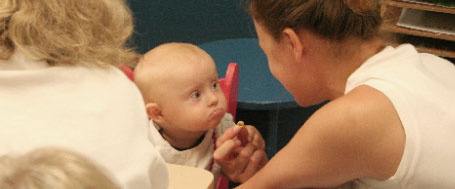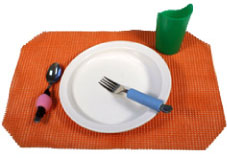
Mealtimes are very important to daily life. They provide special moments for socializing and communicating. It’s also a great opportunity for learning to sit at the table, eat and drink independently. Making the mealtime routine a success requires some special considerations.
As a parent, teacher or early childhood professional, it is important to create a routine that is safe, healthy, positive, and nurturing. Things to consider include: allergies, special diets/food restrictions, and offering food and portions that meet your child’s nutritional needs and his ability to chew and swallow.
A positive and nurturing mealtime environment should include:
- transitioning to the table
- setting the rules and expectations for mealtime
- modeling appropriate behaviours for your child
- helping your child to learn to feed himself
- practising communication and social skills at the table
- doing activities that allow your child to practise the new skills
The following are some suggestions to help you plan the mealtime routine and to ”set the stage” for a positive experience:
Planning the transition to the table
- Have a short and quiet activity before the meal, such as colouring, reading, or doing puzzles. This will help your child to relax, listen, and to follow directions.
- Give warnings before the transition. If possible, use verbal and nonverbal reminders to make sure that your child understands your message. For example, you can say, “In five minutes we will tidy up for lunch”, or show your child a picture symbol of “lunch time” to go along with your words.
- Set a timer to let your child “see” and “hear” that the five minutes are over.
- If your child is playing before the mealtime, encourage him to clean up. Have a bin for the toys nearby so that your child knows where to put the toys.
- Get rid of all distractions during mealtime. Make sure that toys are out of sight and the television is off.

Setting clear rules and expectations for mealtime
By setting rules, children understand that certain behaviours are not allowed. Having simple rules to follow will help your child have a sense of self-control and a desire to cooperate.
- Rules should be said out loud and/or written in two to three-word sentences. You may also want to use visual supports like a rules board and post it near the meal area. (Take a look at the For More Information box at the end of this document for details.)
- Keep the rules to a minimum.
- Discuss the rules with your child or children ahead of time. Have them help you make the rules.
Modeling behaviours
You are your child’s best teacher. Your child watches and imitates you, and through repetition, he learns acceptable behaviours. Try the following ideas to promote appropriate table manners:
- Sit at the table to have the meal with your child or children and model the type of behaviour you expect from him.
- Have the other children role modeling as well. Have them sit next to, or across from, your child to model self-feeding and appropriate behaviours at the table.
Helping your child to learn to feed himself
Learning to eat and drink independently will take time and lots of practice for your child. By making some adaptations, or changes to the area where your child eats and/or the utensils (fork or spoon) he uses, you’re helping him be independent and build his self-esteem.
Consider the following suggestions to promote independence:
a) Seating arrangements
- Make sure that your child has his own space at the table.
- Use placemats to help him identify his own place. You can stick laminated pictures on the mat, or use a specific colour that your child can identify. He will benefit from these visual cues.
- Make sure the seating arrangements accommodate the needs of your child (e.g., offering a preferred spot at the table, sitting next to an adult or peer if help is needed).
b) Positioning
- Your child should be able to sit still with his feet on a stable and firm surface. If necessary, use a step stool to provide support for his feet.
- Use a rubber place mat on the chair to prevent your child from sliding off.
- If your child uses a wheelchair, make sure that there is a clear path for him to access the table and enough space at the table.
c) Recommendations/adaptations for utensils, plates and cups
- If possible, use child-sized plates and utensils.
- If your child has difficulty moving his hands and fingers, he will find it easier to grip a spoon or fork if the handle is enlarged.
- You can make the handle thicker or longer by securing a sponge hair curler or circular foam piece to it.
- A plate with a rim will help to keep the food on the plate while your child is learning to scoop.
- Cups should also be child-sized.
- As your child transitions from drinking from a bottle to drinking from a cup, pour small amounts of liquid into the cup. This will prevent choking and minimize spilling.
- Also, teach your child to hold the cup with both hands, until he is ready to grasp the cup with one hand.

d) Easy steps to promote independence
- At first, you might need to help your child by placing your hand on top of his hand to guide his movements when eating and drinking. Gradually, remove, or minimize your help once your child begins to develop the skills on his own. These strategies are also known as “prompting” and “fading”. See the For More Information box for details.
- The goal is that, eventually, no support will be needed and your child will be eating by himself.
Practising communication and social skills
You can promote your child’s development of social skills during mealtimes, such as learning to ask for food items. Also, your child may find it exciting to help in setting the table, serving the food, and cleaning up when the meal is finished. In this way, you promote independence, a sense of responsibility, and build his self-esteem.
Doing activities that allow your child to practise the new skills
Set up activities throughout the day for your child to rehearse his “mealtime” skills. You can try activities such as cooking (e.g., preparing a simple meal, or a snack), setting up a restaurant play area and reading stories about mealtimes and playing games such as healthy foods bingo.
The mealtime routine is meant to be an enjoyable experience. The time you invest in planning ahead for this routine will allow you to relax and enjoy the results.
References:
Cook, R.; Tessier, A.; Klein, D. (2000) Adapting Early Childhood Curricula In Inclusive Settings. Fifth Ed., Prentice Hall Inc.

